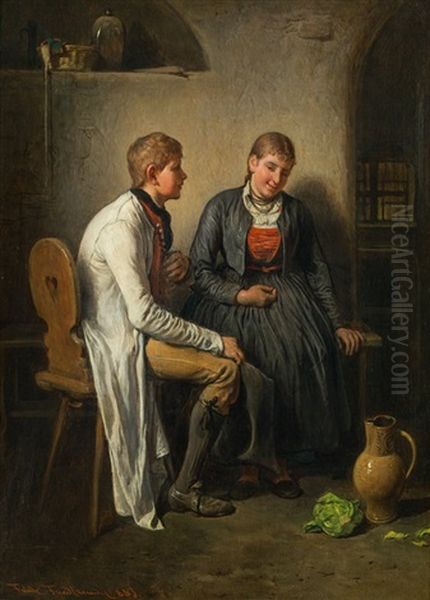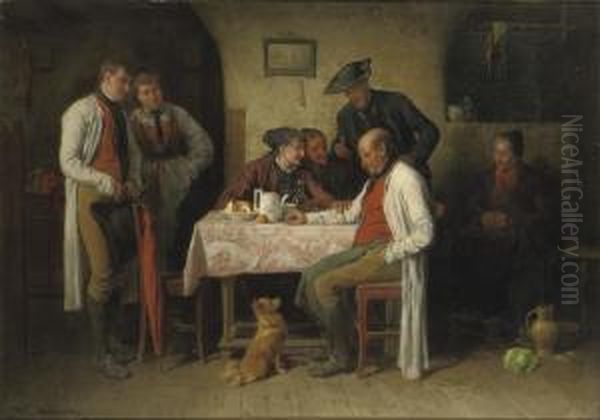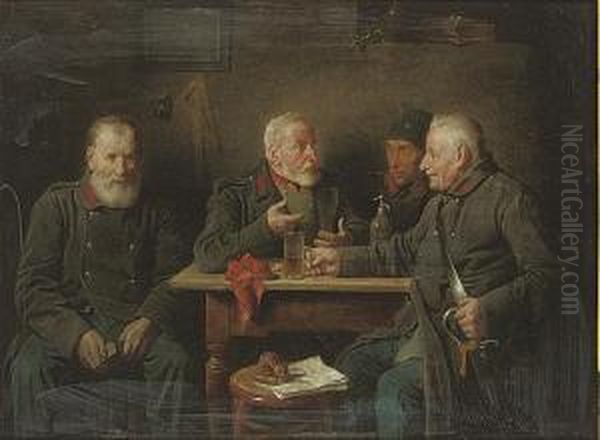Friedrich Friedländer, who later in life became known as Friedrich Ritter von Malheim, stands as a significant figure in 19th-century Central European art. A Bohemian-Austrian painter, he carved a distinguished career primarily through his insightful and meticulously rendered genre scenes. His work captured the essence of everyday life, from the rigors of military existence to the charming local customs of Vienna and the picturesque folk traditions of Swabia. This article delves into the life, artistic development, key works, and historical context of this accomplished artist, situating him within the broader currents of European art during his time.
Early Life and Artistic Foundations in Vienna
Born on January 10, 1825, in Kohlanowitz (now Uhlířské Janovice) in Bohemia, then part of the Austrian Empire (today the Czech Republic), Friedrich Friedländer's artistic journey began in one of Europe's cultural epicenters: Vienna. He enrolled at the prestigious Vienna Academy of Fine Arts, an institution that had nurtured generations of artistic talent. It was here that he laid the groundwork for his technical skills and artistic vision.
A pivotal part of his early training was his time spent under the tutelage of Ferdinand Georg Waldmüller (1793-1865). Waldmüller was a towering figure in Austrian art, renowned as a leading proponent of Biedermeier realism. His influence on Friedländer would have been substantial. Waldmüller was known for his sharp observation, his commitment to depicting reality faithfully, his luminous landscapes, detailed portraits, and, importantly for Friedländer's later career, his engaging genre scenes. From Waldmüller, Friedländer likely absorbed a dedication to meticulous detail, a keen eye for human character, and an appreciation for the narrative potential of everyday subjects. Other Austrian artists of the Biedermeier period, such as Peter Fendi (1796-1842) with his intimate genre scenes and Josef Danhauser (1805-1845) with his morally-tinged depictions of Viennese society, also contributed to the rich artistic environment that shaped young talents like Friedländer.
Broadening Horizons: Travels and Influences

Like many aspiring artists of his era, Friedländer understood the importance of travel for artistic growth and exposure to different schools of thought. In 1850, he embarked on a journey to Italy, the traditional destination for artists seeking to study the masterpieces of the Renaissance and antiquity. This experience would have undoubtedly enriched his understanding of composition, form, and color, even if his own work did not directly emulate classical themes in the long run.
Two years later, in 1852, Friedländer visited Düsseldorf in Germany. The Düsseldorf Academy, under the directorship of Wilhelm von Schadow (1788-1862), had become a major center for painting, particularly known for its school of historical and narrative painting, as well as highly detailed landscape and genre works. Artists like Carl Friedrich Lessing (1808-1880) with his historical and landscape paintings, and Andreas Achenbach (1815-1910) with his dramatic seascapes, were prominent figures associated with the Düsseldorf School. While Friedländer did not permanently align himself with the specific stylistic tendencies of Düsseldorf, the exposure to its emphasis on detailed realism and narrative clarity likely resonated with his own developing inclinations.
Following his time in Düsseldorf, Friedländer eventually made his way to Paris. The French capital was, by the mid-19th century, the undisputed center of the art world, buzzing with innovation and diverse artistic movements. Living and working in Paris, even for a period, would have exposed him to a wide array of artistic expressions, from the lingering influence of Romanticism to the rising tide of Realism championed by artists like Gustave Courbet (1819-1877). The meticulous genre and military scenes of French artists such as Jean-Louis-Ernest Meissonier (1815-1891) might also have offered points of comparison or interest.
Artistic Style and Thematic Focus: A Dedication to Genre
Although Friedländer initially explored historical painting, a genre highly esteemed by academic institutions, his true calling lay in genre painting. From around 1854, he increasingly dedicated himself to this field, finding in it a rich vein for his observational skills and narrative talents. His style is firmly rooted in Realism, characterized by careful drawing, precise rendering of details, and a clear, accessible narrative. He avoided overt sentimentality, instead focusing on a more objective, yet sympathetic, portrayal of his subjects.

Friedländer's thematic interests were diverse within the realm of genre. He became particularly well-known for his depictions of military life. These were not grand battle scenes in the tradition of heroic history painting, but rather more intimate glimpses into the daily routines, camaraderie, and sometimes the hardships of soldiers. His paintings often captured moments of leisure, duty, or quiet reflection, providing a humanized perspective on military existence. In this, he shared some common ground with earlier Austrian military painters like Carl Schindler (1821-1842), known as "Soldaten-Schindler," though Friedländer's approach was distinctly his own.
Another significant focus was Viennese local life. He possessed a keen eye for the characters and customs of his adopted city, translating them onto canvas with charm and authenticity. These works offer valuable visual records of 19th-century Viennese society, capturing its atmosphere and the everyday interactions of its inhabitants. Furthermore, Friedländer developed a reputation for his scenes of Swabian folk life, particularly those depicting Swiss peasant customs. These paintings often highlighted traditional attire, rural activities, and communal gatherings, reflecting a broader 19th-century interest in regional cultures and identities.
Notable Works: Capturing Moments in Time
Several works stand out in Friedrich Friedländer's oeuvre, showcasing his skill and thematic preoccupations. One of his earlier significant pieces, reflecting his initial interest in historical subjects, is The Death of Tasso (created around 1850, though some sources cite 1859, exhibited at the Vienna Academy). Torquato Tasso, the 16th-century Italian poet, was a popular subject in Romantic and academic art, often depicted in moments of suffering or madness. Friedländer's interpretation would have aimed for historical accuracy in costume and setting, combined with a dramatic portrayal of the poet's final moments.
A work that exemplifies his shift towards contemporary genre scenes is People Surging from a Public Building into the Street (1859), also held by the Vienna Academy. This painting likely captures a moment of public excitement or civic activity, allowing Friedländer to depict a diverse crowd and explore the dynamics of urban life. Such scenes required considerable skill in composing multiple figures and conveying a sense of movement and atmosphere.
Many of his most characteristic works are those that delve into more intimate, everyday narratives. Titles like Preparing Dinner (an oil painting measuring 27 x 21 inches, dated 1879 in some records) suggest a focus on domestic activities, rendered with his typical attention to detail in depicting figures, interiors, and still-life elements. Similarly, Old Stories (an oil painting of 31 x 44 cm) likely portrays a scene of intergenerational connection, perhaps an elder recounting tales to younger listeners, a common and beloved theme in genre painting.

Other recorded titles such as Old Friends and Young Couple (the latter dated 1883) further point to his interest in human relationships and the small, significant moments of daily existence. These works, often characterized by their warmth and relatable subject matter, contributed to his popularity among the art-buying public of his time. His paintings were not just aesthetically pleasing; they told stories that resonated with contemporary audiences.
The Viennese Art Scene, Recognition, and Later Career
Friedrich Friedländer was an active and respected member of the Viennese art community. His commitment to the professionalization and promotion of art is evidenced by his role as one of the founders of the Vienna Künstlerhaus (the "House of Artists") in 1861. This association became a vital institution for exhibitions, artistic exchange, and the social life of artists in Vienna. His involvement underscores his standing among his peers.
His contributions to the art world did not go unnoticed. In 1889, a significant honor was bestowed upon him when he was ennobled, receiving the title "Ritter von Malheim" (Knight of Malheim). From this point onwards, he was often referred to by this distinguished name, a testament to his achievements and the esteem in which he was held. This recognition also reflected the broader societal appreciation for artists who successfully captured and celebrated national or regional character in their work.
Throughout his career, Friedländer's works were widely exhibited and collected, not only in Austria but also across Europe. His paintings found their way into numerous public and private collections, ensuring his visibility and influence. He continued to paint prolifically, adapting his style subtly over the decades but remaining true to his core commitment to realistic genre depiction.
Influences and Contemporaries: A Network of Realism
Friedländer's artistic development was, as discussed, significantly shaped by his teacher Ferdinand Georg Waldmüller. However, his work also shows affinities with, and was likely influenced by, other prominent genre painters of his time. Notably, Ludwig Knaus (1829-1910) and Benjamin Vautier the Elder (1829-1898) are often cited in connection with Friedländer.
Ludwig Knaus was a highly successful German genre painter, associated with both the Düsseldorf School and later with Berlin. He was celebrated for his lively and often humorous depictions of peasant life, characterized by meticulous detail and strong narrative content. Benjamin Vautier, a Swiss painter who also spent considerable time in Düsseldorf, similarly specialized in genre scenes, particularly of Swiss and German rural life, rendered with great precision and empathy. The shared interest in detailed realism, everyday subjects, and clear storytelling connects Friedländer with these influential contemporaries. It's plausible that Friedländer's visit to Düsseldorf and his awareness of the broader European art market would have made him familiar with their popular and critically acclaimed works.
Within the Austrian context, besides Waldmüller, artists like Friedrich Gauermann (1807-1862), known for his animal paintings and Alpine landscapes with figures, also contributed to the realist tendencies of the era. While their subject matter differed, the underlying commitment to observing and faithfully rendering the natural world and its inhabitants was a shared characteristic. Even German realists like Adolph Menzel (1815-1905), with his incredibly detailed depictions of historical events and contemporary life in Berlin, represent a parallel development in the broader German-speaking art world, emphasizing keen observation and technical mastery.
It is important to note that while Friedländer was part of this broader movement towards realism and genre painting, he maintained his own distinct artistic voice. His focus on Viennese and military subjects, alongside his Swabian scenes, gave his oeuvre a particular character.
Legacy and Art Historical Position
Friedrich Friedländer, Ritter von Malheim, passed away in Vienna in 1901. He left behind a substantial body of work that provides a valuable window into 19th-century life and artistic tastes. In art history, he is firmly positioned as a prominent representative of Austrian genre painting in the latter half of the 19th century. His work bridges the earlier Biedermeier period, with its intimate focus on domesticity and local color, and the later academic realism that continued to flourish even as modernist movements began to emerge.
His paintings are appreciated for their technical skill, their narrative clarity, and their historical value as documents of a bygone era. While he may not have been a radical innovator in the vein of the Impressionists or other avant-garde artists who were his contemporaries in Paris, his contribution lies in his mastery of his chosen field and his ability to connect with a broad audience through relatable and well-crafted scenes. His works continue to be sought after by collectors and are represented in museums, particularly in Austria and Central Europe.
The confusion that sometimes arises with other individuals named Friedländer – such as the philosopher Salomo Friedlaender (Mynona) or the eminent art historian Max J. Friedländer (who specialized in Early Netherlandish painting) – underscores the importance of clearly identifying Friedrich Friedländer, Ritter von Malheim, as the distinct and accomplished painter of genre scenes. His legacy is that of an artist who dedicated his career to observing and depicting the human condition in its everyday manifestations, doing so with skill, empathy, and an enduring appeal.
Conclusion: An Enduring Observer of Life
Friedrich Friedländer, Ritter von Malheim, was an artist deeply attuned to the world around him. From his formative years at the Vienna Academy under Ferdinand Georg Waldmüller to his travels and his established career as a leading genre painter, he consistently demonstrated a commitment to realistic depiction and engaging storytelling. His scenes of military life, Viennese society, and Swabian customs are more than just charming pictures; they are carefully constructed narratives that offer insight into the values, activities, and social fabric of his time.
As a co-founder of the Vienna Künstlerhaus and a recipient of knighthood, his contributions were recognized within his lifetime. Today, his paintings continue to be valued for their artistic merit and their ability to transport viewers to the 19th century. He stands alongside contemporaries like Ludwig Knaus and Benjamin Vautier as a significant practitioner of genre painting, a field that enjoyed immense popularity for its accessibility and its celebration of the ordinary. Friedrich Friedländer's enduring legacy is that of a skilled and insightful observer, an artist who masterfully captured the multifaceted tapestry of 19th-century life on canvas.